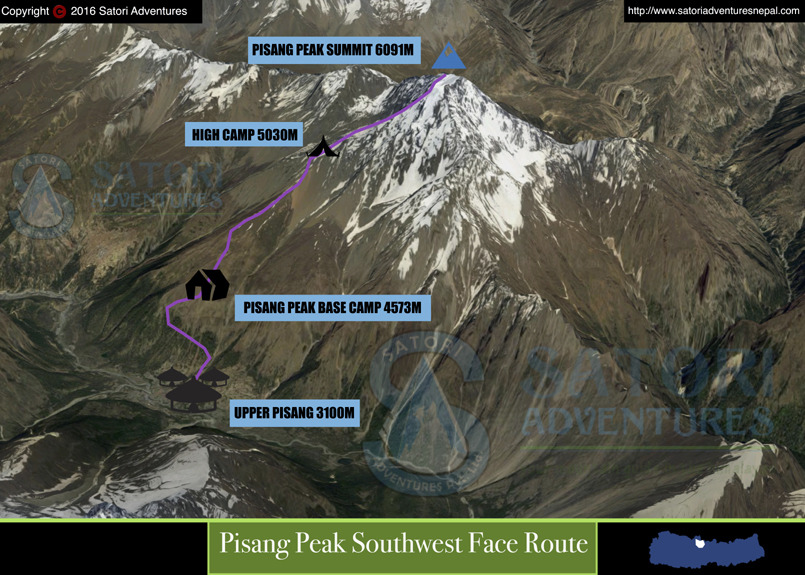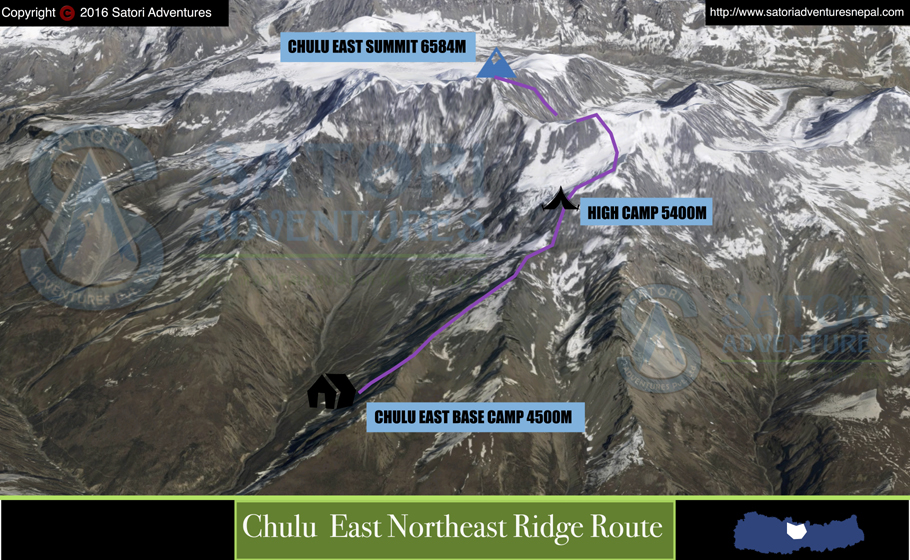Not only is Pisang village known for its yak pastures, but it is also home to Pisang Peak.Pisang Peak is the most popular trekking peak among all trekking peaks in the Annapurna Region of Nepal. It is on the way to the highest pass of the world and offers good scope for exploration. Pisang Peak is also a non-expedition peaks in Nepal that rises opposite of Annapurna II (7937). Pisang Peak lays roughly in between the giants’ Annapurna I and Manaslu—which are eight thousand’smeters mountains. Trekkers with little experience in climbing can combine the popular classic Annapurna circuit trek with Pisang Peak Climbing. In 1955 the German expedition made the first ascent to Pisang Peak. This trek departs from Kathmandu to Besisahar and starts trekking to Annapurna circuit trails, which typically takes 5 days to reach Pisang Base Camp after the summit. After summiting the Pisang peak you will trek to theChulu East base camp to climb Chulu east Peak.
Located on the southern slopes of Manaslu and Annapurna ranges, Chulu East is a classic and rewarding trekking peak in Nepal. It was first ascended in 1955 by a German expedition via the northeast ridge. The ethnic group inhabiting these areas is Gurungs, Magars, Chhetris, Manang, Thakali and the Newars. Chulu East is a difficult climb for beginners. Climbers must be familiar with the use of climbing activities like crampons, harness ice axe, tying knots and handling climbing ropes. After Chulu we make our way up to Throng La Pass at over 5000m; then down into the spectacular Muktinath, another part of the Annapurna Region.
Satori adventures provides you with great opportunities to climb two peaks at one time. After reaching Pisang summit, you can climb Chulu East Peak. Even though these peaks can be climbed throughout the entire year, the most suitable times to climb are autumn and spring. In order to make your journey more comfortable, you will need to take climbing gear and equipment such as Ice Axe, Crampons, standard Carabineers, trekking poles, ropes etc.
Highest access: (6091m/19978ft)
First Ascent: German expedition in 1955, Laurice Nielson and Ang Gyalzen Sherpa. 25 April 1984
Duration: 27 Days
Group Size: 01-10 persons per Group.
Co-ordinates: 28°38’46''N/ 84°11'18''E,
Location: Annapurna Region
Country: Nepal
Airport: TIA(KTM)
Departure From: Kathmandu Airport
Grade: Peu Difficile- (PD-)
Accommodation: Three star to five star as request
Meals: B/B plan in Kathmandu & B/L/D during the trekking and climbing period
Transportation: Three star to five star as request
Best season: Spring (April, May) and autumn (October, November)
Major Activity: Trekking/Climbing
Include Activity: Sights trips of Kathmandu and Pokhara
Culture: Gurung/Thakali
Mode of Travel: Tea House/Camping
Climbing route: Southwest Face
Himalayan sights: Annapurna, Gangapurna, Manaslu
02 Oct/Day 01: Arrival at Kathmandu airport. Transfer to request category hotel accommodation in Kathmandu (1350M/4,430ft)
03 Oct/Day 02: Preparation and briefings at the departments of tourism. Last minute shopping.
04 Oct/Day 03: Drive from Kathmandu to Besisahar (823m/2,700ft, 08hrs) Lodge accommodation.
05 Oct/Day 04: Drive from Beshishahar to Dharapani (1860m/6,103ft, 06hrs) Lodge accommodation.
06 Oct/Day 05: Trek from Dharapani to Chame (2670m/9,055ft, 05-06hrs) Lodge accommodation.
07 Oct/Day 06: Treks from Chame to Upper Pisang (3100m/10170ft, 05 hrs) Lodge accommodation.
08 Oct/Day 07: Rest and acclimatization at Upper Pisang before climb up to Base camp.
09 Oct/Day 08: Trek from Pisang to Pisang peak Base Camp (4573m/15000, 05hrs) Camping.
10 Oct/Day 09: Trek from Pisang base camp to high camp (5030m/16498ft, 06hrs) Camping
11 Oct/Day 10: Day for acclimatize at high camps, As per your physical fitness and weather condition, If you feel comfortable you may attempt the summit (6091m/19978ft) push.
12 Oct/Day 11: Additional day for summit push (6091m/19978ft, 07hrs/), in case previous day was not suitable due to weather or physical condition. Return to the base camp
12 Oct/Day 12: Trek from Pisang peak base camp to Upper pisang (3540m/11611ft, 02hrs) Lodge accommodation.
14 Oct/Day 13: Trek from Upper Pisang to Braka(3800m/12,467ft, 05hrs) tea house accommodating
15 Oct/Day 14: Trek from Barka to Ngwal(4100m/12,467ft, 04hrs) tea house accommodation.
16 Oct/Day 15: Trek from Ngwal to Yak Kharka (4300m/14,107ft, 04hrs) tea house accommodation.
17 Oct/Day 16: Trek from Yak Kharka to Chulu East Base Camp (4500m/14,763ft, 04hrs) Camping
18 Oct/Day 17: Trek from Chulu Base Camp to High Camp (5400m/17,717ft, 04hrs) Camping
19 Oct/Day 18: This is a buffer day. If the team needs to rest and acclimatize an extra day can be spent here. If everyone feels well, you can attempt a summit push (6584m/21,601ft) Camping
20 Oct/Day 19: Summit to Chulu East peak, return to Base Camp. Camping accommodation.
21 Oct/Day 20: Trek from Chulu Base Camp to Manang (3540m/11,614ft, 07hrs) Lodge accommodation.
22 Oct/Day 21: Trek from Manang to Yak Kharka (4350m/14,272ft, 04hrs) Lodge accommodation.
23 Oct/Day 22: Trek from Yak Kharka to Thorong Phedi (4420m/14,501ft, 05hrs) Lodge accommodation.
24 OctDay 23: Trek from Thorong Phedi to Muktinath (3850m/12,631ft, 09hrs) via Thorong La Pass (5416m/17,770ft) Lodge accommodation.
25 Oct/Day 24: Trek from Muktinath to Jomsom (2700m/8,858ft, 04hrs) Lodge accommodation.
26 Oct/Day 25: Flight from Jomsom to Pokhara (950M/3,116ft). Transfer to hotel. Hotel accommodation.
27 Oct/Day 26: Drive from Pokhara to Kathmandu by tourist bus that takes about seven hours also you can take a flight which takes about 25 minutes,overnight at Hotel.farewell dinner with culture program In the Evening.
28 Oct/Day 27: After having breakfast, Drop to airport for final departure, or alternatively join other programs.
27 April/Day 01: Arrival at Kathmandu airport. Transfer to request category hotel accommodation in Kathmandu (1350M/4,430ft)
28 April/Day 02: Preparation and briefings at the departments of tourism. Last minute shopping.
29 April/Day 03: Drive from Kathmandu to Besisahar (823m/2,700ft, 08hrs) Lodge accommodation.
30 April/Day 04: Drive from Beshishahar to Dharapani (1860m/6,103ft, 06hrs) Lodge accommodation.
01 May/Day 05: Trek from Dharapani to Chame (2670m/9,055ft, 05-06hrs) Lodge accommodation.
02 May/Day 06: Treks from Chame to Upper Pisang (3100m/10170ft, 05 hrs) Lodge accommodation.
03 May/Day 07: Rest and acclimatization at Upper Pisang before climb up to Base camp.
04 May/Day 08: Trek from Pisang to Pisang peak Base Camp (4573m/15000, 05hrs) Camping.
05 May/Day 09: Trek from Pisang base camp to high camp (5030m/16498ft, 06hrs) Camping
06 May/Day 10: Day for acclimatize at high camps, As per your physical fitness and weather condition, If you feel comfortable you may attempt the summit (6091m/19978ft) push.
07 May/Day 11: Additional day for summit push (6091m/19978ft, 07hrs/), in case previous day was not suitable due to weather or physical condition. Return to the base camp
08 May/Day 12: Trek from Pisang peak base camp to Upper pisang (3540m/11611ft, 02hrs) Lodge accommodation.
09 May/Day 13: Trek from Upper Pisang to Braka(3800m/12,467ft, 05hrs) tea house accommodating
10 May/Day 14: Trek from Barka to Ngwal(4100m/12,467ft, 04hrs) tea house accommodation.
11 May/Day 15: Trek from Ngwal to Yak Kharka (4300m/14,107ft, 04hrs) tea house accommodation.
12 May/Day 16: Trek from Yak Kharka to Chulu East Base Camp (4500m/14,763ft, 04hrs) Camping
13 May/Day 17: Trek from Chulu Base Camp to High Camp (5400m/17,717ft, 04hrs) Camping
14 May/Day 18: This is a buffer day. If the team needs to rest and acclimatize an extra day can be spent here. If everyone feels well, you can attempt a summit push (6584m/21,601ft) Camping
15 May/Day 19: Summit to Chulu East peak, return to Base Camp. Camping accommodation.
16 May/Day 20: Trek from Chulu Base Camp to Manang (3540m/11,614ft, 07hrs) Lodge accommodation.
17 May/Day 21: Trek from Manang to Yak Kharka (4350m/14,272ft, 04hrs) Lodge accommodation.
18 May/Day 22: Trek from Yak Kharka to Thorong Phedi (4420m/14,501ft, 05hrs) Lodge accommodation.
19 MayDay 23: Trek from Thorong Phedi to Muktinath (3850m/12,631ft, 09hrs) via Thorong La Pass (5416m/17,770ft) Lodge accommodation.
20 May/Day 24: Trek from Muktinath to Jomsom (2700m/8,858ft, 04hrs) Lodge accommodation.
21 May/Day 25: Flight from Jomsom to Pokhara (950M/3,116ft). Transfer to hotel. Hotel accommodation.
22 May/Day 26: Drive from Pokhara to Kathmandu by tourist bus that takes about seven hours also you can take a flight which takes about 25 minutes,overnight at Hotel.farewell dinner with culture program In the Evening.
23 May/Day 27: After having breakfast, Drop to airport for final departure, or alternatively join other programs.
For full board clients we provide a personal tent and food, which will be prepared by their climbing Sherpa. We provide UHF/VHF hand held radios on the mountain to maintain communications between ABC and high camps.
We provide a personal climbing Sherpa guide each group(2:1 ratio) to help the clients reach the summit. The secret of success on ls and is a strong and experienced climbing Sherpa. No matter how good and experienced the climber, it is a long slog. Personal climbing Sherpas will set up camp. They will also carry food provisions, fuel and assist the client on the summit day.
Satori Adventures and Expedition aims at giving proper information to many travelers, trekkers and climbers who have some confusion regarding the booking process of the trip in Nepal. Satori Adventures therefore desires to provide guideline for the first-time visitors or travelers so that they can comfortably start the process to book the selected package legally. Before starting the booking process we always advise our trekkers, travelers and climbers to intelligently check whether the company is genuine and whether they are fully safe to travel in the company’s guidance. We ask them to be acquainted with the company they want book their holiday trip with. Is the company genuine and authorized from Government of Nepal, Office of the Company Registrar, Department of Tourism and Civil Aviation, Nepal Rastra Bank ‒Central Bank of Nepal (authorized for foreign currency), Permanent Account Number (PAN), and the Department of Cottage & Small Industries). Are they financially secured and environmentally conscious? We advise them to make sure about these formalities because there are some companies in Nepal that have been running business without abiding by the rules and regulation of the Government. Some companies were once registered but by now their licenses have already been expired and yet they have providing the services illegally.
On many occasions, Government of Nepal and Trekking Agency Association of Nepal have found that many foreigners’ tour operators, NGOs and INGOs have been involved in directly operating tours, trekking, and mountaineering holiday adventures without having government license and abiding by the Government rules. It has been also found that many individuals, freelance guides and porters have been arranging trips illegally by creating their own personal website. We have observed that many trekkers and climbers face a host of problems once they arrive in Kathmandu as they lack adequate information. Many of them file complaints to Government of Nepal and Trekking Agency Association of Nepal for legal action such as the refund of the advanced payment. There is hardly any justice given to the cheated clients. Thus, so as to prevent all these probable problems we request our travelers to check the company before booking any trip to the Himalayas.
To conform and process your trip booking please follow these suggestions:
Please kindly submit Trip Booking Form when you confirm the trip with us. It will be easy for us to process for your trip conformation and prepare all legal processes and permit for the trip. If you have any query, always feel free to contact us at any time. We always want to make sure our clients are well informed before conforming the trip. You are always advised to visit our website and related package for further information.




Satori Adventures Pvt. Ltd.
P. O. Box-21378, Naya Bazaar, Kathmandu, Nepal
Phone: +977-1-4965127
+977-1-4951250
Email: info@satoriadventuresnepal.com
Fax: +977-1-4965127
Mob: +977-9851031006
www.satoriadventuresnepal.com